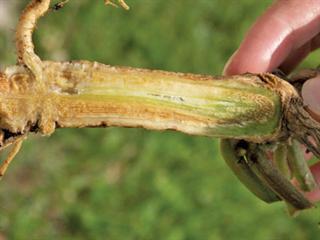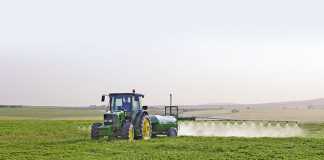
Where I live on the Highveld, I’m often subjected to rainy periods during the growing season and as my sole purpose for growing this crop is variety evaluation, I often experience the consequences of disease. Simply put, a wet year separates the resistant varieties from the rest. All the serious diseases are fungal.
Some can be brought in by seed, so you have to be particular when choosing where to buy your seed. Infected seed may not be too serious in a favourable year, but can be devastating in a wet year.
Fusarium
The greatest threat is probably Fusarium oxysporum. Anyone contemplating growing watermelons for the first time needs to determine the resistance of the variety being considered. Resistance does not mean that your watermelons will be free from the disease. Even resistant varieties can become infected when weather conditions are favourable and the fungus is present.
Resistant varieties will simply hold out for longer and may not get the fungus at all.The first symptoms will be visible on the youngest growth, where wilting occurs even when the soil is clearly sufficiently moist. If there is a general lack of moisture – during the heat of the day, for example – you will see the entire stand wilting slightly. If Fusarium is present, the wilting will start in patches and spread along the row from there.
Often, only one side of the plant will wilt. When symptoms are severe, the stem near the ground will show browning of the conducting tissue when cut through. The roots may also become discoloured. This disease can be transmitted by seed. It can live in the soil for a long time and extended rotations are therefore advised – preferably up to eight years. It may not be necessary to wait this long, however. Make a note of the situation at harvest; if there are no symptoms of the disease, you should be able to plant sooner.
Anthracnose
Another disease responsible for serious damage is anthracnose, which starts at any stage of growth when weather conditions are humid and rainy, and can spread fast. Within a week, the entire land can have a burnt appearance. It is rarely a problem in dry areas under normal weather conditions. Three strains of the disease occur. If you live in an area where anthracnose occurs, choose a variety with resistance.
Fungus sprays can be used when the weather is favourable or at the first signs of the disease. These include round, reddish brown spots on the older leaves and the appearance of a bare area near the crown, which becomes clearer when looking down the rows. If the fungus strikes at a later stage, these symptoms may appear only at the market.
Damping off
Common to a wide range of crops, damping off is usually caused by one or more of three different fungus genera. It is a disease closely associated with residual crop litter and is likely to occur when the worked land has a high moisture content. The physical properties of the soil, together with climatic conditions, can cause much damage. Well-prepared soil in a good physical condition seldom has a damping off problem.
Gummy stem blight
Often introduced through infected seed, gummy stem blight is found in watermelons as well as other cucurbits. It can cause crown rot, stem cankers and – less commonly – fruit rot. Gum oozes from the stem cankers, causing the runners to die off. Round or irregular spots – brown in colour – develop on the leaves. The severity of this disease is also associated with inclement weather. If such conditions are expected and the disease is known to be present in that land, apply fungal spray before the onset of symptoms. I am not aware of any resistant varieties.













